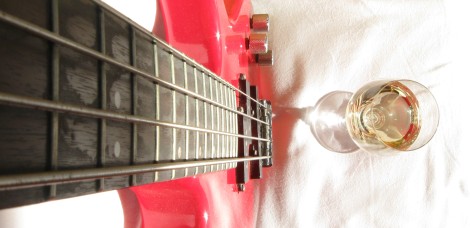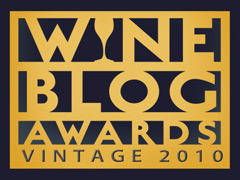Category Archives: Germany
February 25, 2011 Weingut Tesch
Weingut Tesch Karthäuser
Germany (Nahe)
riesling

There are punk rockers loose in the vineyards of Germany.
Well, a few. And they don’t require pesticides.
Weingut Tesch has struck a deal with the long-lived punk rock band Die Toten Hosen (web translator: The Dead Trousers…uum) to market a dry riesling they’ve labelled Weisses Rauschen (White Noise). Winery owner Martin Tesch rather likes rock music and he’s rather determined to bring a new face to German riesling.
‘Dry’ is the key descriptor, a world away from the sweet riesling that many people still associate with Germany. Tesch, following a Ph.D. in microbiology, took over the family winery fifteen years ago. The winery (which dates back to 1723) has seen many Teschs at the helm, though none as radical as Martin. By 2002 he was into an overhaul of the winery, abandoning the poorer-producing north-facing vineyards and getting rid of all varietals except riesling and pinot noir, bringing the area under vine to just 20 hectares. The production of medium-sweet and sweet wines (except for a small amount of eiswein when conditions are right) was halted. Emphasis shifted to single vineyard bottlings.

And the look of the bottles themselves — radically new (and award-winning in design), taking a u-turn away from the traditional German wine language-laden label, into something simpler, and, of all things, colour-coded (using the colours of the London Underground lines!). Not only that, production was now organic, and Tesch began using the Stelvin Lux closure instead of cork. He reduced substantially the selling price of his wines. Wine sellers in Germany were not impressed. Several cut him loose. But Tesch had astutely read the market. What he had done was appeal to new, younger wine enthusiasts tired of the old image of German wine. He was being hip, while at the same time giving more than a nod to the traditions of fine winemaking. The austere man pictured on the labels is his great grandfather.
Recently Tesch teamed up with Gibson guitars and criss-crossed Germany with a concert and wine tour — the Rolling Riesling Show. One of his best known wines is labelled “Unplugged”. Another “Deep Blue”. The names of his single-vineyard rieslings are a bit more traditional. The wine up for tasting is Karthäuser, a name derived from Carthusian monks who once grew grapes on the slopes; a brown-toned image of them is on the label. Like the other sites, Karthhäuser is classified Grosses Gewächs (Grand Cru). The grapes grow in weathered red slate, protected from the harsh winds by the surrounding hills. Intervention in the winery is minimal. Says Tesch, “I wanted to leave no winemaking imprint on the wines, to have the wines clearly express their origins.”
Unoaked, unfiltered, unfined, and unplugged.

Weingut Tesch Karthäuser 2009
Light polished gold in the glass. On the nose — clean and delicate, slight turn of spice, another of tropical fruit. Mouthwise, it’s smooth and dry, with an effervescent touch. Tasty restrained citrus with fine mineral overlay. All in all, a delightful riesling of character. Life-affirming. One surely as welcome with classical as it is with punk. $
Or sautéed salmon.
Tags: Karthäuser, Kevin Major, Martin Tesch, organic wine, Tesch, Vinland, Weingut Tesch
- 4 comments
- Posted under Germany, organic wine
January 28, 2011 Reichsrat von Buhl
Reichsrat von Buhl Armand
Germany (Pfalz)
riesling
http://www.reichsrat-von-buhl.de

In the January snow is a bottle from the estate which supplied the wine to toast the opening of the Suez Canal, and which could count among its fans Elizabeth, the Queen Mother, who tipped a glass of Buhl riesling on her hundredth birthday.
Reichsrat von Buhl dates back 150 years. It is in the Pfalz region of Germany, an 80-km stretch of vineyards just north of Alsace in France. The climates of the two regions are very similar. And like Alsace, Pfalz has been traditionally known for its white wine.
The estate’s key historic figure was a politician and close friend of Bismark, Franz Armand Buhl, after whom today’s wine is named. In the latter part of the 19th century he groomed the estate to an international award-winning reputation. It was a time when Buhl rieslings brought higher prices than did the wines of Bordeaux and Burgundy.
 As Germany’s fortunes declined in the 20th century so too did those of Reichsrat von Buhl. Its vineyard holdings fell to a quarter of what they had once been, although, fortunately, the best sites were retained. Today the 55-hectare estate is owned by entrepreneur Achim Neiderberger, its operations leased to a company that includes the estate’s managing director
As Germany’s fortunes declined in the 20th century so too did those of Reichsrat von Buhl. Its vineyard holdings fell to a quarter of what they had once been, although, fortunately, the best sites were retained. Today the 55-hectare estate is owned by entrepreneur Achim Neiderberger, its operations leased to a company that includes the estate’s managing director  Stefan Weber. Under Weber, and with considerable investment in new facilities and with a young, committed team behind him, the estate has re-established itself as one of Germany’s leading wineries. It has been operating organically since 2005.
Stefan Weber. Under Weber, and with considerable investment in new facilities and with a young, committed team behind him, the estate has re-established itself as one of Germany’s leading wineries. It has been operating organically since 2005.
The soil here is variegated sandstone. Yields are firmly controlled and harvesting is selective. Fermentation is carefully monitored to produce a clean, pure wine, with maturation in temperature-controlled stainless steel tanks. It is racked after eight weeks and eventually bottled without fining. The results find their way to wineshops of the world bearing the distinctive label designed in 1887 by the famous German Symbolist and Art Nouveau painter and engraver Franz von Stuck.

Reichsrat von Buhl Armand 2009
The Armand Riesling is designated Kabinett, which by German wine law indicates wine made from fully ripened grapes in a light style, non-chaptalized (no sugar added to increase the alcohol level after fermentation). This Kabinett is semi-sweet, with 8.7 g/l of residual sugar. The level of alcohol is just 8.3%.
With lightness comes elegance. It has a clean mineral nose with an understated fruit quality. A measure of spritz on the palate, giving way to a near citrus juiciness, but with a saline edge. Tasty. A definite personality. Nobody’s fool. Not to my tasting partner’s taste, but I can’t get enough of it. $
Tags: Armand Riesling Kabinett 2009, Kevin Major, organic wine, Reichrat von Buhl, Stefan Weber, Vinland
- Leave a comment
- Posted under Germany, organic wine
May 7, 2010 Dr. Loosen
Dr. Loosen Wehlener Sonnenuhr Riesling Auslese
Germany (Mosel)
riesling
You have to start with Dr. Loosen himself. That’s Ernst Loosen, who, it’s been said, ‘single-handedly put German wine on the world stage in the 21st century.’ Considering the limp reputation of German wine just a couple of decades ago, that’s a considerable compliment, especially coming as it did from the erudite wine critic Jancis Robinson.
on the world stage in the 21st century.’ Considering the limp reputation of German wine just a couple of decades ago, that’s a considerable compliment, especially coming as it did from the erudite wine critic Jancis Robinson.
Friends tell me of a time when the German wine of choice was either ‘black or blue’ — Black Tower or Blue Nun. Easy drinking for the wine philistine, sold by the truck load. As palates improved, the German estates failed to catch up. It took someone with the surefire energy and determination of the wild-haired Loosen to lead the way into refocusing winemakers’ attention to quality.
Loosen, whose academic background is archaeology, turned to winemaking when his father fell ill in the mid-1980s. He transformed the winery on his own terms, refocusing its operations to meet organic standards. He cut the crop size, and aimed for fully mature fruit, with minimal intervention once the grapes were harvested. He strove for distinctive regional expression in his wines, and this he has achieved, spectacularly.
The Loosen estate is among the choicest along the Mosel, with some vines dating back a hundred years. The site of this particular wine is Wehlener Sonnenuhr (the sundial of the town of Wehlen), notable for the steepness of it slopes, ultra-thin topsoil, and ‘the purest blue slate in the Mosel valley.’

Dr. Loosen Wehlener Sonnenuhr Riesling Auslese 2005
German wines are classified, not on the basis of region like French wines are, but on sugar content. This is an Auslese (select harvest) riesling. It is non-dry (as opposed to dry or sweet) from an exceptional vintage. The wine glows pale yellow in the glass. The nose, although not as strong as I anticipate, draws wine-loving attention with its soft fruit aromas, peach especially, touched by lemon rind. What is held back on the nose is more than compensated for by the taste. Delectable is understating it. Concentrated creaminess, but edged very nicely by the acidity and mineral notes. Nectar coats the palate, a slight effervescence playing against the sweetness. Indeed, it is, in two words — mouth-watering.

The alcohol level is a mere 7.5%. Its character draws it near to some lighter dessert wines. There is a fine interplay of acidity and fruitiness. Great with spicy foods or to savour on its own terms. $$
Riesling is a hard sell in some quarters. That wasn’t always the case. At one time it rivalled in price the best Bordeaux. It seems to be making a comeback. In doing so it doesn’t try to be all things to all wine drinkers, unlike what one might say of the chameleon chardonnay. It seeks believers. In rain, in shine.

Tags: Dr. Loosen, Ernst Loosen, Kevin Major, Mosel, organic wine, riesling, Vinland, Wehlener Sonnenuhr 2005, wine
- Leave a comment
- Posted under Germany, organic wine

 Following his wine studies at the prestigious Geisenheim Institute, he spent time on wine estates outside his homeland, and was particularly influenced by what he experienced in Burgundy, where a sense of terroir is so integral to winemaking. (Hence, his current experimentation with pinot noir.) For now riesling, the stalwart of German varietals, remains his major focus. He seeks to bring to it a definite sense of place. Even the basic entry level riesling, which includes our chosen bottle, is soundly marked by the soil and care taken in the vineyards. (A distinct step away from the Blue Nun of my college days.)
Following his wine studies at the prestigious Geisenheim Institute, he spent time on wine estates outside his homeland, and was particularly influenced by what he experienced in Burgundy, where a sense of terroir is so integral to winemaking. (Hence, his current experimentation with pinot noir.) For now riesling, the stalwart of German varietals, remains his major focus. He seeks to bring to it a definite sense of place. Even the basic entry level riesling, which includes our chosen bottle, is soundly marked by the soil and care taken in the vineyards. (A distinct step away from the Blue Nun of my college days.) Very light in the glass, but casting a greenish hue. Light, spritz-like nose of clean white fruit. There is an attractive semi-sweet purity, with a graceful touch of the earth behind it. I think of pink grapefruit, the acid cutting the sweetness nicely. Not at all cloying in the way that some rieslings can be. Lovely harmonious nose and palate, with a very pleasant aftertaste. $
Very light in the glass, but casting a greenish hue. Light, spritz-like nose of clean white fruit. There is an attractive semi-sweet purity, with a graceful touch of the earth behind it. I think of pink grapefruit, the acid cutting the sweetness nicely. Not at all cloying in the way that some rieslings can be. Lovely harmonious nose and palate, with a very pleasant aftertaste. $

